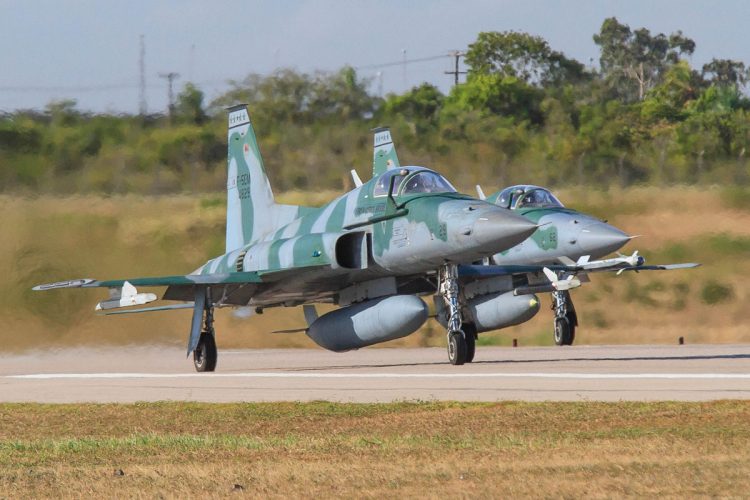With only 42 F-5EM supersonic fighters in service, supported by 80 AMX and EMB-314 attack and counter-insurgency aircraft, Brazil is one of the countries with the weakest combat air force relative to its economic power. . In 2014, Brasilia ordered 32 JAS-39 Gripen E single-engine fighters as well as 8 two-seater Gripen F for operational transformation for $5,5 billion, to replace the Tigers acquired in 1974, with an important technological agreement allowing the local assembly of at least 15 devices. However, the changes demanded by Brasilia quickly increased the note by $1 billion, while at the same time, Stockholm committed itself to an industrial and economic compensation package of $9 billion. The first Gripen was delivered to the Brazilian Air Force in 2019, and all aircraft should be produced by 2027.
However, this order has always represented, in the minds of the Brazilian Air Force, a first batch of aircraft, when they already estimated in 2015 that they needed 108 combat aircraft to cover the entire territory. . It is in this context that, according to the Reuters agency, Brasilia and Stockholm would have started new negotiations with a view to ordering 40 new Gripen E/F fighters, so as to arm a second air base, with a delivery target before 2040. It is true that with 8,5 million km2 , Brazil must have at least an air force spread over several air bases, if only to carry out air policing missions above its territory. However, this indiscretion comes at a time when several South American air forces have undertaken negotiations or consultations with a view to modernizing or even extending their own air forces, and in an increasingly tense international context.

Basically, Brazil has no declared adversary to date, largely due to its particularly inclusive international policy, including with countries on the margins on the international scene such as Iran, North Korea or Venezuela. Furthermore, the country has good relations with all its neighbours, and has no past or present territorial disputes. However, Brasilia has undertaken in recent years a major effort to modernize and expand its armed forces, with the acquisition of 4 submarines Scorpene and the development of a national nuclear attack submarine with the support of the French Naval Group, 4 class frigates Tamandaré developed with the German TKMS, or the acquisition of 98 Italian light tanks Centaur II or more than 2600 armored vehicles Guarani. In addition, it is making significant efforts to acquire advanced capabilities, such as in the space sector with the planned order of several communication, reconnaissance or observation satellites, in air superiority with the order of 22 multi-purpose aircraft (transport/refuellers) KC 390 and 2 DO NOT MRTT, as well as 5 Awacs Embraer R-99 and 6 SIGINT aircraft, or even the stated ambition to acquire, by 2040, an aircraft carrier and a class of anti-aircraft destroyers.
There are 75% of this article left to read, Subscribe to access it!
The Classic subscriptions provide access to
articles in their full version, and without advertising.
Meta-Defense celebrates its 5th anniversary!

- 20% on your Classic or Premium subscription, with the code Metanniv24
Offer valid from May 10 to 20 for the online subscription of a new Classic or Premium, annual or weekly subscription on the Meta-Defense website.



I don't quite understand the principle of a “€9 billion industrial and economic compensation package” for a main contract of €5,5+1 billion. First, why do we need compensation? What would be their nature? And why compensation of an amount close to double the main contract?
This is called offset. In the negotiation, one of the conditions is that the client invests a certain amount in certain economic activities of the country. Investing does not mean paying. It is a relatively common device in recent years, and widely used by some countries including Brazil and India. The seller is free to refuse. but that is the condition.
I imagine that there is a small typing error, and that it is the seller who undertakes to invest in the client country? So Sweden sells 6 billion euros of planes, but on condition of investing 9 in the country's economy. It is indeed quite persuasive. I imagine that France must therefore have invested enormous sums in the Indian economy…
From memory it was €4 billion on an €8 billion contract. But the difference was that all Rafale Indians were produced in France. These are the team companies Rafale who invested. Dassault, for example, has developed the production of certain elements of the Falcon in the country. Safran, for its part, supported the indeterminate in the development of the Kivari turbojet.
[…] have been drawn up for the Gripen, with Brazil, the only export customer of the Gripen E, which has announced its intention to increase its fleet in the years to come, the return of the Gripen option to Thailand after the American refusal of […]